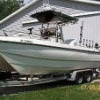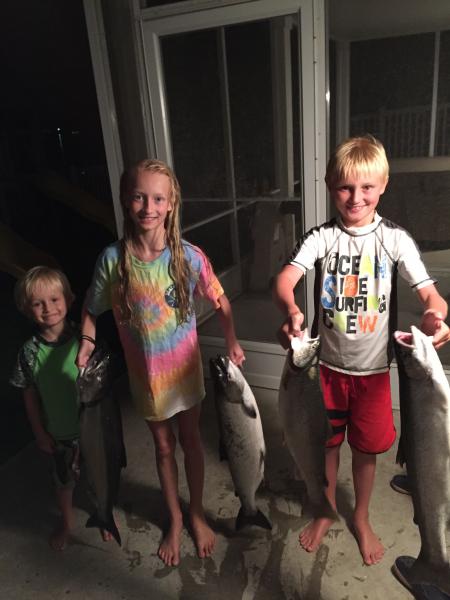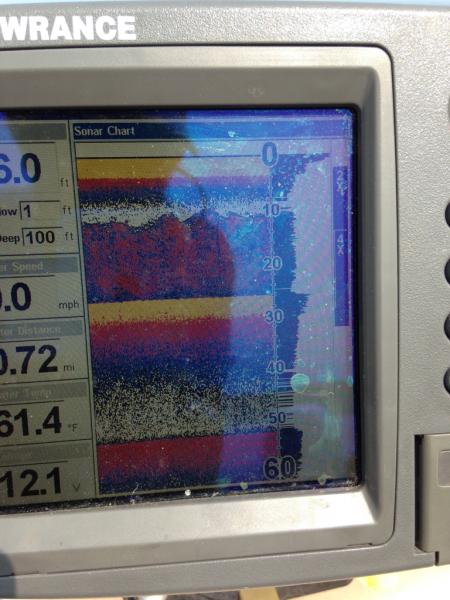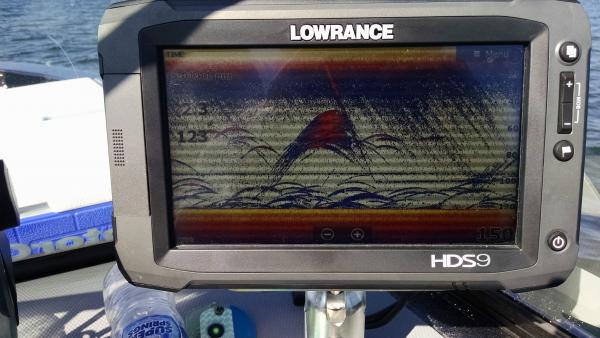-
Posts
844 -
Joined
-
Last visited
Content Type
Profiles
Forums
Events
Store
Gallery
Everything posted by SeaCatMich
-

Penn 320 gti copper capacity
SeaCatMich replied to barley35's topic in Great Lakes Fishing Discussion
If you know the capacity of either reel in mono (usually can find on the reel or look up on the Penn web site) you can calculate the equivalent capacity in leadcore or copper using the reel fill calculator MS Excel spreadsheet that is in this post: http://www.greatlakesfisherman.com/forums/showthread.php?t=16491 BloodRun does have a PDF document that has copper dive curves on page 1 and reel capacities on page 2. It lists the capacities for many different reels and if you know a reel that is size comparable to the 320 it should get you in the neighborhood. The BR chart uses their 30# mono for backing so if you go with 30# braid you should get 2x as much backing. -
Have gone to Torpedo Diver's ball bearing snap swivels from Sampo. Very good quality, nice round snap for good lure action, welded ring and with a somewhat unique snap design that makes it nearly impossible for it to come undone unless you do it... and a better price. 45# size most of the time.
-

Wanted Fishhawk 800/840 parts
SeaCatMich replied to tangled up's topic in Classifieds - Buy, Sell, Trade or Rent
If you can't find a probe, you can use the new X4 probe with the 840. Does much better with batteries than the original 840 probe -- 4 AA will last a whole year. -

holland - the evening of 7-19
SeaCatMich replied to 2MD's topic in Michigan Waters Fishing Reports - Salmon and Trout
-
Being at a port with/without natural reproduction has little to do with the spring & summer catches. The salmon go all over the lake until ready to stage for sawing runs. Southern Wisconsin has no natural reproduction and have been doing well. Holland doesn't either. Until the last couple of weeks, Ludington, Manistee & Frankfort have been terrible this year too.
-
With as cold as it has been (relative to a typical summer) the normal water temps have not setup and consequently the salmon are not in traditional locations. Fishing does seem to be picking up quite a bit the last week or so, but still not what would be expected for mid July. A north or east wind still moves cold water into the normal fishing grounds and moves fish to other locations. With no "hot" water around, the fish can use all of the lake which scatters them across the lake -- horizontally and vertically. There has been pretty good action for Lake Trout and Steelhead out of many ports. Southern Wisconsin waters have had more consitant salmon catches but with the winds and air temps, that is where a lot of what could be called warm water has been pushed. We just need a week of clear skys with some "summer" heat and low winds to get some action jump started on the Michigan coast. These same cool temps have meant great walleye fishing in Saginaw Bay and the western basin of Erie for much longer into the summer than often happens.
-
Twin Honda 90 HP 4 strokes, 2 40 gallon tanks on my 21' center console. Can typically get 4 or 5 trips out of full tanks -- runs out/in on both engines, alternate between the two when trolling. My trips are usually all day affairs 6 am to 7 pm with average of 10 miles out but often 15+. Living 2-4 hours from the lake boat fuel is the cheap part of the trip compared to towing it over and back with the Avalanche at 12 mpg.
-
I would suggest taking a look at a video that Lance Valentine has put out on YouTube. Lance is founder of the Walleye101 company and his expertise is on fishing electronics. While his emphasis is on walleye, he is a good multi specie fisherman and his tips on HDS setup apply to all fishing situations with the units. Here is a link to the video: https://youtu.be/fqL6wyz2sww https://youtu.be/fqL6wyz2sww
-
If your graph has multiple frequencies try using the higher one when on plane or view it in dual frequency mode. On mine, the 50 kHz is a wider beam but once the boat is above 7 mph too much clutter/static to see fish. The 200 Khz is a much narrower beam but is good up to my cruising speed. Most of the time at the high speed the fish mark more as spots or vertical bars rather than arches since they are not in the beam long enough to form the arch.
-
Holland has been a good port the last few years. Getting to the ramp is a little bit of a trek with having to go through so much town to get there, but it is a real nice ramp and a great fish cleaning station. Most years by now I would say start deeper but with the water temps so weird this year (maybe we will still get some real summer) it is as good as anywhere. Watch the wind. An east wind moves what warmed water there was/is out from shore and colder water from deeper offshore will flow in to replace it - putting cold water on the beach. In normal years this is great because it is 70+ water being replaced by 50 something water and the fish follow the colder water into the shallower areas. A north or northwest wind will do similar, but it is moving cold surface water in from offshore or "up north". While temps are important and can help identify active fish, when I first head out I use my graph to look around until I find fish. Mine can mark fish when I'm on plane up to about 27 mph so when I see a mark or two I then slow down and run at 5-8 mph looking for concentrations of fish. It does take some time working with the graph to ID fish at higher speeds -- they aren't the nice arches you get at trolling speed. Once I find fish then I put out the lures and start looking at temps. Mainly the temps are used to help narrow down what fish are most likely to be active, but I am more likely to fish marks not temps. If I get both coinciding... bonus! Getting the speed right with underwater currents can have as much or more to do with catching fish as temps. That is when the downspeed part of my FishHawk really gets important. When you get a hit note the speed and the direction you were going. Also note if you were turning as that affects speed on the inside and outside lines.
-
Dennis, where are you fishing out of?
-
I would say that the three big red marks in the middle are likely salmon or trout. The rest are probably not game fish. On the Lowrance there are many settings that will affect how what is being detected is displayed. Gain, frequency, noise rejection, color pallet, screen speed, boat speed, ping rate... Putting the unit on "auto" will show the data on the screen but it does not optimize what you will see. In the case of what is shown, I would say that the red marks are fish if the color pallet selected is one with red being the most dense returns BUT since the bottom readings are showing yellow then orange and then red, I would say that the pallet selected has yellow for the hardest returns. The "red" fish could still be salmon/trout since the other fish returns don't have any (all black) and are not thick at all but if the color in the fish returns was yellow, I would be more inclined to say that they were game fish for certain.
-
Generally for salmon/trout the thermocline you want is a rapid change in temps in the 45 to 55 degree range. By rapid it is when the temp changes 2-4 degrees in less than ~5' of depth.
-
Yes, the CoastWatch satellite temp charts are very useful. If it is in the "probably cloudy" shaded area the temps can be unreliable, but in the white areas the data is good. Yes too on the reading it like a topographical map - each line is a 1 degree change in temp so lots of them close together is a rapid change. Typically I run lines with the shallowest presentations out farthest from the boat and then progressively deeper as you get closer. So for example it would go wire diver on 1, high diver on 3, 300 copper, fullcore, half-core, 3 color. Same can apply to downriggers but I often run them higher than other lines since the leads off the rigger are not usually as long. By setting things up with the V pattern (deep inside, shallow outside) it lets you put any line back into the spread. If you had them random or with deep on the outside of shallow then when redeploying a deep line it would hit the shallow ones on the outside. Same thing when you get a hit -- the fish will tend to move toward the center of the boat (down the chute) and with an outside line shallower than the one inside it, the fish will usually go over the shallower one.
-

Stolen equipment
SeaCatMich replied to Manorth's topic in Michigan Waters Fishing Reports - Salmon and Trout
Not good. In the 6 years I lived at Eagle Point I never had a problem and left everything except removable electronics on the boat -- removed them to keep them out of the weather. Had to have a gate card to get in -- has that changed? I would make sure to report it to the police as well. You may not be the only boat to have been hit. -

Why do people hold fish out when taking photos?
SeaCatMich replied to U D's topic in General Discussion
Some people do it because they think the person taking the picture is photographing the fish -- not the person and the fish. I have had others who don't really want to hold it so they want it as far away as they can. But, I agree most of the time it is because they want to make the fish look bigger -- or someone taught them to do it this way because they wanted to make the fish look bigger. Funniest thing to me is how most people don't know how to hold a fish for a picture and get their hands in the picture in front of the fish. First I don't like seeing the fingers/hands but those holding it out to make it bigger don't think about how the hand to fish size really tells me how big the fish is. The better way to hold the fish is to insert the fingers from one hand in the gill on the side of the fish facing the person and the fingers of the other hand go under the fish between the pelvic and anal fins. Basically the same way you hold the barrel of a baseball bat when buning. -
From what I have observed, read and have discussed with Dan & others, the thought is that inactive/resting salmon go into the colder, deeper water -- 42 to 46*. When actively feeding they will basically follow the food -- alewife if possible. Most of the time this will be in the 47 to 52* temps -- which happens to be the alewife's preferred comfort range too. But if the food goes into warmer water, especially in low light conditions, the salmon will follow. The prefered temp for lake trout is in the 42 to 48* range but when actively feeding they too will follow the bait into warmer water. If you can find a thermocline -- which I doubt there are any really setup yet this year since in general the lake has not warmed enough to have any -- you can often find active feeding fish but not always. For active fish, bait is more important. For inactive fish they may orient to the thermocline, but both lake trout and bigger kings will also orient tight to bottom. In a thermocline the rapid temperature change (2-4 degree change in less than 10' of depth change) also has density changes which will both bait and predators will orient to. They can be feeding above or below it. Same thing for surface temperature breaks (horizontal thermoclines) where the water density difference caused by the temperature difference will accumulate "stuff" including insects to make a scum line and the insects attract both bait and predators. In many ways the water temperature changes are the structure that fish orient to -- especially in southern Michigan waters of Lake Michigan where there really isn't much structure compared to other parts of the lake.
-
A lot depends on the settings on the Lowrance but from what I see on your pics of the screens, I don't think that many of the marks are salmon or trout. My guess would be whitefish -- especially those near bottom. Salmon and trout will generally have thicker marks in the middle with black on top and yellow or red in the "body" of the arch. The uniformity of the arches indicate that the fish are not very active either -- moving/active fish usually will have arches that are more skewed to one side with partial arches. The suspended marks in the upper right side of picture 2 are probably salmon or trout. The other uniform "upside down V or U" ones are more typical of stationary or slow moving fish that are passing fully through the beam of the fishfinder.
-
Your 9.9 4 stroke probably is around 90 to 100 pounds. I would think the boat is designed by Lund to not have problems with 100 extra pounds on the rear -- that is much less than the average guy standing back there. Do you have other extra things in the rear? If not, I think I would talk to a Lund dealer as this doesn't seem right.
-
Outdoorsman Pro Shop in Jenison has Familiar Bite herring strips and Green Label whole herring. These might not be Kent County, but they are close! Lakeshore Tackle Outfitters just of the north Saugatuck I196 exit stocks it. So does Fish-On Bait & Tackle off the Nunica exit on I96 going toward Grand Haven.
-
If the boat is noticeably stern heavy then I'd suggest making some adjustments. If you don't have anything to balance it and it is getting too much water in the splashwell at rest or slow speed, then you might want to look into some trim-tabs. They act like flaps on an airplane to lower the bow when under power. Had them on V hull boats in the past and they are great for making the boat run level with different load distributions and also allow you to compensate for quartering into waves and still run level. My boat is rated for dual 90 hp outboards... so that is what I bought on it. BUT since it is a '96/97 hull the rating was for 2 strokes, not the Honda 4 strokes I bought with it in '99. The 4 strokes are about 200# each heavier than the same power engines in 2 strokes. Consequently the stern sat about 2" lower than it is supposed to and that put the outlets for the deck drains right at the water level and water comes in rather than draining out. To try to solve the problem I moved the batteries (4 @ 50# each) from under the rear jump seats near the splashwell to under the center console. That helped, but when you get one or two people in the stern it still does not drain like I wish it would. So I have a couple of rubber plugs that I use to keep the water out. I'd like to move some more weight toward the bow, but there really isn't anything else for me to shift.
-
If the tracks are mounted well it shouldn't be a problem. Hardest part will be cranking the heavier weights up since you will probably put them deeper
-

Ludington 7/3
SeaCatMich replied to In The Net's topic in Michigan Waters Fishing Reports - Salmon and Trout
The Steelhead out on the temp breaks/scum lines are usually pretty active. Have caught them running speeds up to 3.5 mph. Another great lure is a size 3 plug off any of the presentations that In The Net described. Oranges, chromes, lime greens, pinks are all good colors. An SWR on a rigger down 10-20' can be productive as well. -
Blood Run is the only one I'm aware of producing 60# copper. From what is shows on their web site it is only available in 200' or 1,000' spools. Franks Great Outdoors up in Linwood has the 300' listed on the web site but says it is out of stock.
-

Ludington 7/3
SeaCatMich replied to In The Net's topic in Michigan Waters Fishing Reports - Salmon and Trout
Good job reacting to the changing conditions and reading the water. So many people are not willing to adjust their program and location and then complain when the fish are not where they were the day before. I love fishing that deep water program out of Ludington to Onekema. You never know what is going to be on the line.




